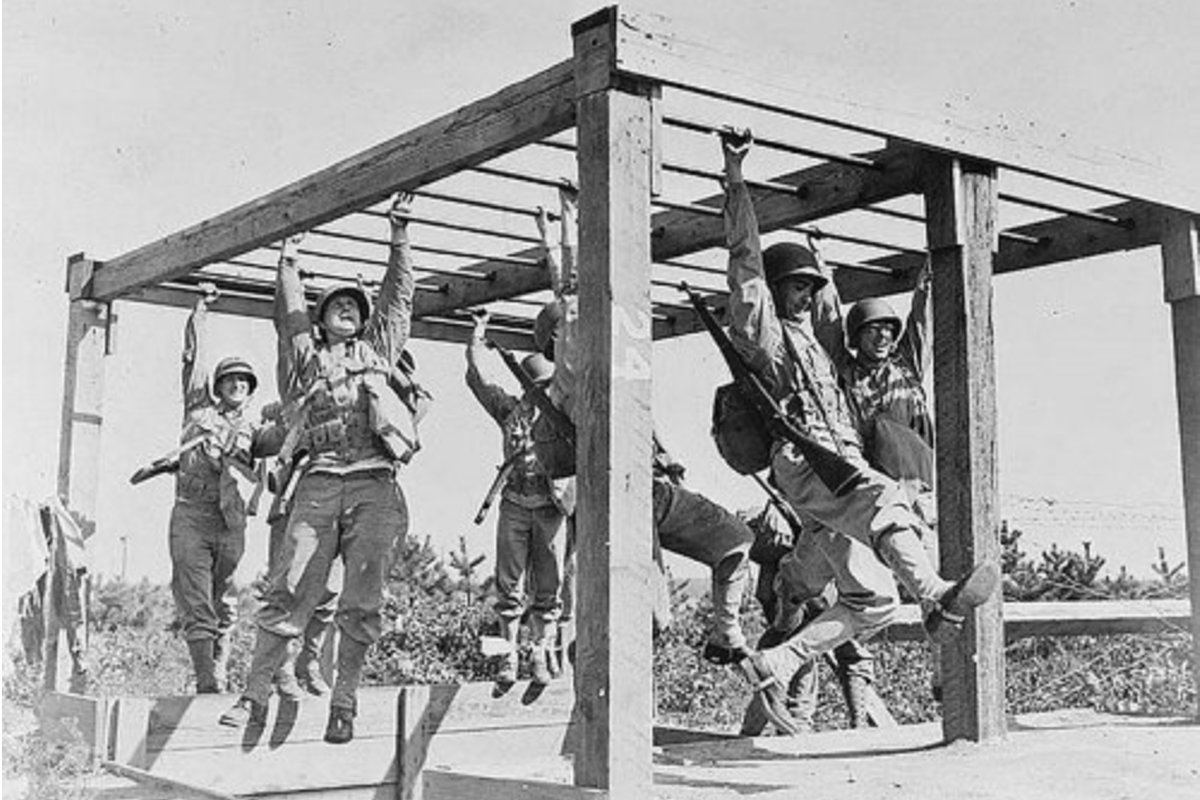An Abbreviated History of Army Fitness Standards From World War II to Present

Enlisted men train on an obstacle course during World War II. Photo courtesy of the Library of Congress.
“All Soldiers must be ‘sold’ upon the necessity of being in excellent physical condition. The leader must convince the men that a high level of fitness will give them a much better chance to survive in combat situations. When troops realize their efforts are an investment in their own personal welfare it is not difficult to secure their whole-hearted cooperation.” — Army Regulation 20-21
In America, one out of every three adults is considered obese. This isn’t just a personal problem — it’s a national crisis. Estimates show that 75 percent of 17 to 24 year olds are ineligible to join the military, and more than half of those are due to health problems and a lack of physical fitness.
The problem has even moved into our military’s ranks. A study conducted in 2018 shows that 66 percent of service members are considered to be either overweight or obese. With that sobering statistic in mind, what standards are soldiers being held to?

The U.S. Army first introduced “Physical Training – AR 21-10” in March 1941 when World War II was still raging. After a few minor changes, an updated version was released in January 1946.
The regulation used a total fitness concept to plan and conduct physical fitness training, emphasizing strength, endurance, agility, and coordination.
The physical fitness test included a series of events that were conducted one after another with little or no break between events.
The tests were designed to measure the components of physical fitness, as well as to motivate the men to improve themselves. There was no such thing as a “failure.” The soldiers were simply classified into one of four categories per event — excellent, good, fair, or poor. Commanders were encouraged to keep profiles of each soldier, indicating their strengths and weakness in order to shift training requirements.

Changes occur frequently and consistently in the military. When the Vietnam War was coming to an end, the Army switched its physical training philosophy from preparing for combat to a general concept of health. An increasing number of females were joining the ranks, so the test was scaled to accommodate. The goal was to create a test that could be easily administered with little to no equipment.
The Army Physical Fitness Test (APFT) was introduced in 1980. The APFT consists of three components: two minutes of push-ups, two minutes of sit-ups, and a 2-mile run. Soldiers are expected to test at least twice a year and earn a score of 180 in total, and at least 60 points in each category.
Testing is no longer a tool for motivation but rather a must-pass situation. Soldiers cannot promote, re-enlist, or attend most military schools without a passing score. Although the APFT can predict a soldier’s combat effectiveness, it is only about 40 percent accurate.
However, it appears that senior Army leaders have taken heed from the World War II PT style with last year’s announcement of the Army Combat Fitness Test. The ACFT, which is replacing the APFT, is expected to be fully fielded no later than October 2020.
The new test includes six events, and its work-to-rest ratio is three times that of the APFT. Events include the deadlift, standing power throw, hand-release push-ups, sprint-drag-carry, leg tuck, and a 2-mile run. Soldiers will be expected to complete all events in less than 50 minutes.
The new test is supposed to be a better indicator of combat effectiveness. Estimates show that the ACFT has 80 percent accuracy in predicting the individual combat effectiveness of a soldier. It may turn out that the best way to solve the Army’s fitness problem is to take a look back in time.

Katie Whelan is a contributing writer for Coffee or Die Magazine. She holds a bachelor’s degree in Liberal Studies from Thomas Edison State University and is an active duty U.S. Army staff sergeant, assigned to 1st Special Forces Group. Katie also plays center and defensive end for the Seattle Mist (LFL) football team and is a two-time national champion. She is a Minnesota native but currently resides in Washington state with her daughter.
BRCC and Bad Moon Print Press team up for an exclusive, limited-edition T-shirt design!
BRCC partners with Team Room Design for an exclusive T-shirt release!
Thirty Seconds Out has partnered with BRCC for an exclusive shirt design invoking the God of Winter.
Lucas O'Hara of Grizzly Forge has teamed up with BRCC for a badass, exclusive Shirt Club T-shirt design featuring his most popular knife and tiomahawk.
Coffee or Die sits down with one of the graphic designers behind Black Rifle Coffee's signature look and vibe.
Biden will award the Medal of Honor to a Vietnam War Army helicopter pilot who risked his life to save a reconnaissance team from almost certain death.
Ever wonder how much Jack Mandaville would f*ck sh*t up if he went back in time? The American Revolution didn't even see him coming.
A nearly 200-year-old West Point time capsule that at first appeared to yield little more than dust contains hidden treasure, the US Military Academy said.












